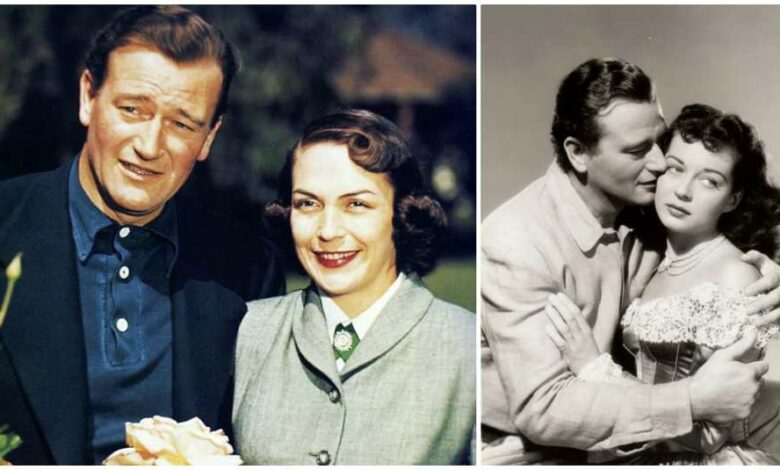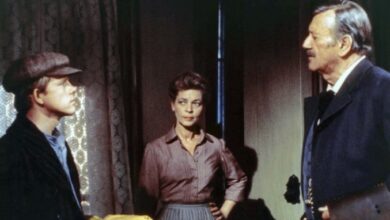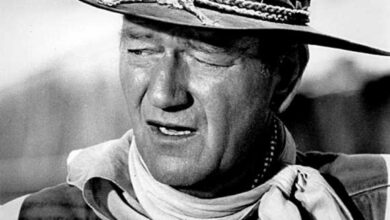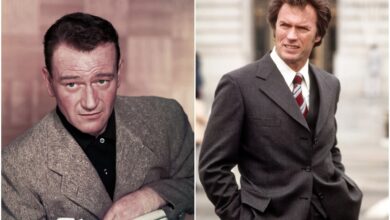The Man Behind The Cowboy: 23 Little-Known Facts About John Wayne

Ladies’ Man
John Wayne’s on-screen persona opposite his cinematic love interests was often shy, bordering on awkward. But when the cameras stopped rolling, Wayne was actually a brazen womanizer. He was married three times and had a total of seven children, but none of his marriages went particularly well. He was consistently and flagrantly unfaithful to all three wives, having long and public affairs with some of the most famous women in Hollywood, most notably Marlene Dietrich and Joanne Woodward.

“Daddy, Get Me That”
Iconic German actress Marlene Dietrich was famous for her beauty, intelligence, and skill in knowing – and getting – exactly what she wanted. When she saw John Wayne for the first time at the Universal commissary, she is said to have nudged her agent and said, “Daddy, get me that.” She was at the height of her popularity when it came time to cast for Seven Sinners, and she demanded that John Wayne play the leading man, setting off their famous three-year affair.

More Than Just Romance
Marlene Dietrich and John Wayne would go on to star in two more movies together, The Spoilers and Pittsburgh. Meanwhile, their affair carried on and intensified, as John fell head over heels for the fascinating actress. More than just a romantic affair, the two became the best of friends, bonding over their shared love of making films and enjoying many of the same hobbies together. They also appeared in public often as co-stars, but this was enough to get people talking and the affair became public.

The Toxic Film Set
In 1956, Howard Hughes made a movie called The Conquerer, starring Wayne as Mongolian warlord Genghis Khan. This was a case in which the filming location might have ended up being more treacherous than a real battlefield. The film was shot in Utah, right near a nuclear weapon test site, exposing the cast and crew to fallout. In 1981, People magazine noted that out of the film’s 220 cast and crew members, 91 had developed cancer and 46 of them had passed away, including John Wayne himself.

“He Had The Magic”
Through his many years of tumultuous romantic affairs, Wayne made no secret of his long love affair with film star, Maureen O’Hara. The two first met at a dinner party at the home of director John Ford in 1941, and O’Hara recalls being instantly taken with the actor. “Wayne would have to sing for his supper which caused great merriment because he couldn’t sing,” Maureen recalled. Despite the humiliation, she claims, “He had credibility. He had manliness. He had the magic.”

Tough Enough For Wayne
It wasn’t only Wayne who found an admirer in O’Hara – the feeling was clearly mutual. The pair’s chemistry read well on the screen, as the pair made five movies together including the classic The Quiet Man. The fiery O’Hara proved a worthy foil to John Wayne’s forceful presence. “I was the only leading lady big enough and tough enough for John Wayne,” she wrote in her memoir. “Duke’s presence was so strong that when audiences saw him finally meet a woman of equal…fire, it was exciting and thrilling.”

His First Wife Tried To ѕһoot Him
Of John Wayne’s three divorces, his most dramatic was probably from Esperanza Baur, a former Mexican actress. She suspected Wayne of having an affair with his co-star from Angel and the Badman, Gail Russell, a claim which both actors denied. The night the film wrapped, Wayne came home very late from the usual wrap party. By the time he reached home, Esperanza was in an intoxicated rage and attempted to ѕһoot him as he walked through the door.

A Controversial Interview
Recently, an interview of Wayne that was published in a 1971 Playboy magazine that cast him in a pretty unflattering light has resurfaced, sparking a huge controversy around the star’s legacy. Specifically, Wayne was quoted as saying that he “believed in white supremacy until the blacks are educated to the point of responsibility”. Regarding Native Americans, Wayne thought that America did no wrong in “taking this country away from them,” and that they were “selfishly trying to keep it for themselves.”

He Never Fought In The War
While Wayne appeared in countless World War II movies portraying fearless heroes, he actually never served in the real war himself. While fellow actors of the era like Jimmy Stewart and Henry Fonda went off to serve their country, John Wayne deferred his deployment at first so he could get a leg up in Hollywood. But the temporary deferment dragged on as his star-power rose, and by the last couple years of the war, he was so entangled with Marlene Dietrich that he just never ended up serving at all.

The Original Duke
John Wayne was born as Marion Robert Morrison in Winterset, Iowa in 1907. As a child, he had a best friend – the family dog, an Airedale terrier named Duke. The two were so inseparable that people started calling the young Marion “little Duke.” As he wasn’t exactly a fan of his own name, he began to adopt the name “Duke” as his own, and by the time he was an adult, he practically refused to be called by his given name.

He Stayed Down-To-Earth
The actor known as John Wayne kept his feet on the ground throughout his career, remaining down-to-earth despite his stardom. His secret? He kept his “real self” and his “actor self” divided into two different personas. “The guy you see on the screen isn’t really me. I’m Duke Morrison, and I never was and never will be a film personality like John Wayne. I know him well. I’m one of his closest students. I have to be. I made a living out of him,” he once explained.

It Wasn’t His, But It Was Real
John Wayne might have been the paragon of manliness, but his image took a hit when his hair began to thin in his 30s. He began to wear a hairpiece – a fact that didn’t go unnoticed. In fact, during a visit to Harvard in 1974, one student rudely asked him, “Where did you get that phony toupee?” His response was as calm, cool, and collected as John Wayne could ever be. He backfired, “It’s not phony, it’s real hair. Of course, it’s not mine, but it’s real.”

More Sailor Than Cowboy
Although he was known as America’s favorite film cowboy, the real John Wayne didn’t really enjoy horseback riding at all, refusing to get on a horse unless it was absolutely required for a scene and never riding in his leisure time. Instead, Wayne preferred sailing on his yacht, The Wild Goose, and was overall much more drawn to the sea than the range. He had even surfed as a young man, after his parents moved the family from Iowa to southern California.

Cameo Man
As one of the biggest film stars in America for decades, John Wayne was invited to do quite a few cameos on popular TV shows. One of his most memorable appearances was an episode of I Love Lucy in which he plays himself, where Lucy sneaks into the famous actor’s trailer, gets caught red-handed by Wayne, and pretends to be his masseuse in order to avoid getting into trouble. For an appearance on Beverly Hillbillies, he asked to be paid with a bottle of his favorite beverage.

He Was In Star Wars
Not many people know that John Wayne had actually turned up in the original Star Wars movie. But he didn’t ride horseback into town as a space cowboy. In fact, it was only his voice that made an appearance, used for the voice of imperial spy Garindan. However, the audio was so processed and manipulated that by hearing it, one would never have been able to tell it was Wayne. In fact, the voice barely sounds human at all.

The Everyman’s Hero
Late into his career, Duke Morrison revealed the secret behind what gave John Wayne the everyman appeal that had made him such a success. The character was created to fill a void in Hollywood: “I’ve found a character the average man wants himself, his brother, his kid to be,” he said. “It’s the same type of guy the average wife wants for her husband. Always walk with your head held high. Look everybody straight in the eye. Never double-cross a pal.”

The Injury That Made Him A Star
If it weren’t for one fateful accident, John Wayne would have never come to be. While studying at the University of Southern California on a football scholarship, Morrison sustained a serious shoulder injury while bodysurfing, losing him his place on the team. When college got to be too expensive, he was forced to leave and start working odd jobs on movie sets, which is where he was discovered. It just goes to show that what seems like the worst thing that could happen often brings unexpected positive turns in life.

Hands-On Dad
Ethan Wayne, John’s youngest child, revealed in his memoir that despite his father being a famous actor, the ailing John was aware that he had limited time with his son and so was determined to spend as much time with him as possible. “He took with me on location. I’d be homeschooled down on location in Mexico because he knew he wasn’t going to be around for me when I was older… So he took me with him when I was little.”

Health Troubles
In the ’60s, Wayne’s years of smoking five packs a day finally began to catch up with him. He began to develop a hacking cough and became out of breath easily. His attitude of, “maybe it’s six months off the end of my life but they’re not going to κıււ me,” ended up backfiring horrifically. While filming In Harm’s Way with Otto Preminger in 1964, he began to have brutal coughing fits and people began to realize something was seriously wrong.

The Big C
Sadly yet unsurprisingly, John Wayne developed lung cancer. John Wayne was the first person to refer to cancer as “The Big C.” He came up with the idiom to make his struggle with the illness less “scary” to studio executives in the early 60s. In his first battle with cancer, Wayne lost a rib and half of one lung, and yet he still managed to hold a press conference in his own living room shortly after in order maintain his strong public image.

He Was Almost κıււed By The KGB
Joseph Stalin might have been a John Wayne fan, but he was not a fan of Wayne’s vocally anti-communist views. His solution was to send two KGB assassins after him who were thankfully foiled by the FBI. But the story didn’t end there. When Stalin’s successor, Nikita Khrushchev, visited the US in 1959, he made just two requests – to visit Disneyland, and to meet John Wayne. When they met, he apologized on Stalin’s behalf, reassuring John, “I rescinded the order.”

No Filming After Noon
At the height of his career, John Wayne was treated like royalty on the set, and he was such a big name by the ’60s that he called the shots on set. One of his unusual rules (which doubtless made filming with him incredibly difficult) was that none of his scenes were filmed after 12 noon. Why? Well, Wayne had what would be defined today as a drinking problem, and as soon as noon rolled around, he would hit the bottle. His drinking and smoking habits ultimately caused his fatal health problems.

Words To Be Remembered By
Originally, John Wayne asked that his tombstone be engraved with the words, “Feo, Fuerte y Formal,” – “ugly, strong, and dignified.” But when he finally succumbed to stomach cancer at the age of 72, a quote from his controversial Playboy interview was engraved on his tombstone instead: “Tomorrow is the most important thing in life. Comes into us at midnight very clean. It’s perfect when it arrives and it puts itself in our hands. It hopes we’ve learned something from yesterday.”






